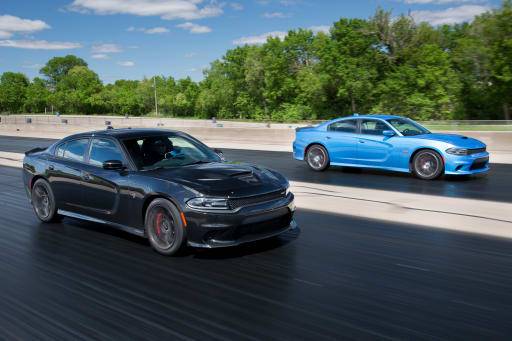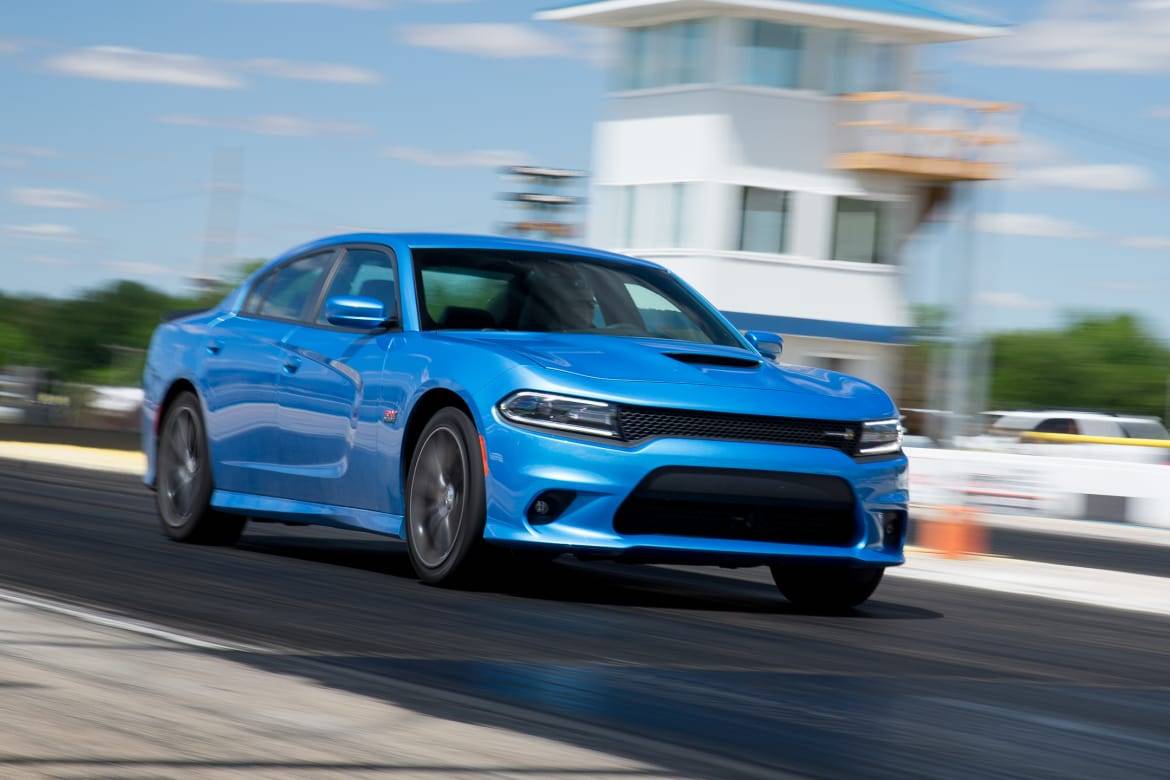Drag-Strip Tested: 2015 Dodge Charger R/T Scat Pack


CARS.COM — The redesigned 2015 Dodge Charger’s huge range of engines gives buyers the option to pick their power, from a 300-horsepower V-6 up to a whopping 707-hp, supercharged V-8. On the performance end of the spectrum are two wallops of a dollar-to-horsepower bargain with the $40,990, 485-hp Charger R/T Scat Pack and $64,990, 707-hp Charger Hellcat — prices include destination as well as the Charger Hellcat’s $1,700 gas guzzler tax.
We drag-strip tested the 707-hp Charger Hellcat at the same time a Charger R/T Scat Pack was in Cars.com’s test fleet, so we had to take the Scat Pack down the quarter-mile to see just how well the Charger Scat Pack holds up to its attention-hogging bigger brother.
Related: Challenge Won: We Do 11 Seconds in the Dodge Charger Hellcat
The Charger R/T Scat Pack is a blend of the 370-hp Charger R/T and 485-hp Charger SRT 392, using the SRT’s 485-hp 6.4-liter V-8 with fewer features than the SRT to keep the price low. Those include a fixed-firmness suspension instead of an adaptive adjustable-firmness suspension, four piston brake calipers instead of six, 245-mm-wide tires instead of 275-mm wide and a number of convenience options left on the table. All Chargers use an eight-speed automatic transmission, and the Scat Pack’s is built a bit daintier than the Hellcat’s beefy unit.
With 222 less horsepower than the Hellcat muscle car and at $24,000 less expensive base price, the all-new Scat Pack still pulled impressive quarter-mile times for a full-size sedan. Dodge says to expect mid-12 seconds, and we managed a best of 12.39 seconds at 112.44 mph out of the 4,400-pound sedan. The Scat Pack proved substantially easier to drive than the Hellcat — surprising no one — cracking off a number of 12.4- and 12.5-second runs with little more effort than flooring it off the line.

The Hellcat’s speed wasn’t there, but the sound of the exhaust most definitely was with the volume and raucous tone of an aftermarket exhaust system thanks to the Scat Pack’s active exhaust system, the same type used on the SRT 392 and Hellcat.
Differences between the Hellcat and Scat Pack go beyond its performance at the drag strip. On the road, the high-performance Hellcat is more hunkered down with hydraulic-assisted power steering providing more direct feedback. Also, you can truly tell the difference between supple Street mode and firm Track mode with the adaptive suspension. The Scat Pack’s fixed suspension creates a more disruptive ride quality, and the electronically assisted power steering isn’t as confident, with much less resistance in the steering wheel.
Still, a 12.39-second run, while not the mind-warping acceleration of the Hellcat’s 11.0-second capability, is fast enough to hurt the feelings of a few Ford Mustang and Chevrolet Camaro owners at your local drag strip’s test and tune night.

Managing Editor Joe Bruzek’s 22 years of automotive experience doesn’t count the lifelong obsession that started as a kid admiring his dad’s 1964 Chevrolet Corvette — and continues to this day. Joe’s been an automotive journalist with Cars.com for 16 years, writing shopper-focused car reviews, news and research content. As Managing Editor, one of his favorite areas of focus is helping shoppers understand electric cars and how to determine whether going electric is right for them. In his free time, Joe maintains a love-hate relationship with his 1998 Pontiac Firebird Trans Am that he wishes would fix itself. LinkedIn: https://www.linkedin.com/in/joe-bruzek-2699b41b/
Featured stories




